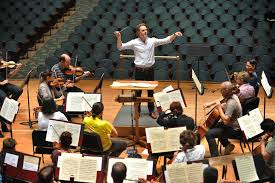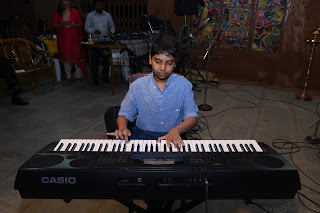While writing a management-type essay about how an organisation could be structured as an orchestra is, and, how an orchestra is a perfect example of a holarchy, I adapted it as a standalone essay on the orchestra as a holarchy
WHAT'S HOLON & HOLARCHY
So what’s a holarchy?
“A Holarchy is a ‘Natural Hierarchy’ of Holons”, said
Arthur Koestler, who coined the words ‘holon’ and holarchy to refer to an
entity that is in itself a whole and is simultaneously part of some other
whole.
And what’s a holon? A
Holon is a whole and a part. Just as a particle is complete by itself and
exists by itself but becomes part of another complete entity - an atom, it yet
retains its completeness and its identity. A Holon too, is a complete entity
which in addition to maintaining its own autonomy as a whole, simultaneously
fits in as a part of something else. Its own existence, though complete,
depends upon its capacity to fit-in and be part of something else. For
instance, a whole atom is part of a whole cell, and the whole cell is part of a
whole organism, and so on... in an increasing form of wholeness - from atoms,
to molecules, to plants, to animals and to humans. Each of these entities is
both a whole and a part - a ‘whole/part’, a Holon.
A ‘holarchy’ is
simply an order of increasing wholeness. For example: particles > atoms >
cells > organisms, or, letters of the alphabet > words > sentences
> paragraphs. The whole of one level becomes a part of the whole of the
next.
A natural hierarchy,
for example is - Date > Month > Quarter > Year. Or - Cities >
States > Countries > Regions > Continents.
When one says, “the whole is
greater than the sum of its parts” that means that the whole is at a
deeper or higher level of organisation than the parts alone – that’s
a Holarchy!
The words Holon and
Holarchy that were neologised by Arthur Koestler were examined explored by Ken
Wilber in his book “A Brief History of Everything” and it is from this book that
I have summarised and rearticulated the ideas of the holon and holarchy.
AN ORCHESTRA
AS A HOLARCHY
An orchestra, or a
jazz band or a choir are perfect examples of a Holarchy.
For an orchestra, the
score, written in musical notation, are the written rules and guidelines for
the part each member of the orchestra sings or plays on their individual
instrument to suit the section to which the instrument belongs, and the score
is arranged so that all the several different instruments, voices and
instrument-groups play their different written parts to blend harmoniously
together.
Each musician, instrument
voice and instrumentalist play a specific part which is complete by itself, but
which also merges into the section of which it is part, and each section of the
orchestra augments and enhances the sound of the whole orchestra. This is what makes
an orchestra “a whole that is greater than the sum of its parts”. And this is
typical of a holarchy.
We will look
at how a large group of musicians, is organised and constructed to produce
music.
 A
symphony* orchestra is composed of a large group of organized
instruments which usually play classical music compositions, and could
have as many as 100 musicians in it, and perhaps, in a large 100 piece symphony
orchestra, around sixty or seventy would play stringed instruments and the rest
would play other instruments. A Jazz band or choir could also have many
musicians playing many instruments and have many singers in them.
A
symphony* orchestra is composed of a large group of organized
instruments which usually play classical music compositions, and could
have as many as 100 musicians in it, and perhaps, in a large 100 piece symphony
orchestra, around sixty or seventy would play stringed instruments and the rest
would play other instruments. A Jazz band or choir could also have many
musicians playing many instruments and have many singers in them.
The string section of a
symphony orchestra is: first violins, second violins, violas, cellos and double
basses. One or two harps may also be part of the symphony orchestra.

 The woodwind
section is next - woodwinds are usually composed of flutes (including alto
and bass flute), piccolos, oboes (including bass oboe), cor anglais, clarinets,
bass clarinet, bassoons and a double bassoon.
The woodwind
section is next - woodwinds are usually composed of flutes (including alto
and bass flute), piccolos, oboes (including bass oboe), cor anglais, clarinets,
bass clarinet, bassoons and a double bassoon. Then there is the brass section,
the instruments which comprise the brass section of a symphony orchestra are
the trumpet, cornet, trombone (including the alto and bass trombone), French
horn and tuba.
Percussion instruments - Not
all percussion instruments will be included in a symphony orchestra. The
percussion instruments are usually the xylophone, bass drum, tympani and piano.
A jazz orchestra or big band is also an organisation of a
large number of musicians who play a variety of musical instruments that play
Jazz or any orchestrated music.

A Jazz orchestra or Jazz band is also divided into sections, for example, Charles Mingus’s big band compositions had a Woodwind section of Alto saxophones, tenor saxophones, baritone saxophones, Bassoon, bass clarinet; and piccolo, flute, oboe and clarinet.
The Brass section had Trumpets, French horn, trombones,
tuba. And the Rhythm section had - Piano, Bass, drums, vibes (vibraharp),
guitar, percussion. Sometimes a jazz orchestra or jazz band has a few strings,
and occasionally, a symphonic string section to complement the orchestra.
In a choir a group of voices is divided in to four parts of voice pitches and tones:
An orchestra
exemplifies and illustrates a ‘Holarchy’
The orchestra or jazz
band or Choir is structured so that all are equally important to each other and
interdependent. Each voice or instrument is like a Holon, which
maintains its own wholeness, identity and autonomy, yet fits in as a
part of something bigger than itself. Each voice or instrument is part of
a section, like the string section or woodwinds or brass or percussion, yet
each plays its own part in the section it belongs to and each section, plays
its part according to its role in the orchestra.
So, an orchestra is constructed as
a Holarchy and comprises equally important independent parts which would
increase in its wholeness as it grows. Though each voice or instrument is
capable of being a soloist and independent, it is part of a higher level,
which, in turn fits into another part at a deeper or higher level of the
orchestra, making
the whole greater than the sum of its
parts. Q.E.D.
*A symphony orchestra or a philharmonic orchestra is the same thing, but
the words symphony or philharmonic are only used to differentiate orchestras.
When there are two good orchestras in a city, one would call itself a symphony
orchestra and the other a philharmonic orchestra for e.g. the New York
Philharmonic Orchestra (NYPO), founded
in 1842, and
the New York Symphony Orchestra founded in 1878, which, till today, entertain
discerning audiences with a high quality of music with only their distinctive
names to differentiate them.
https://reformcommunications.blogspot.com/2013/10/organisation-as-orchestra-as-holarchy.html
https://reformcommunications.blogspot.com/2013/10/organisation-as-orchestra-as-holarchy.html







































